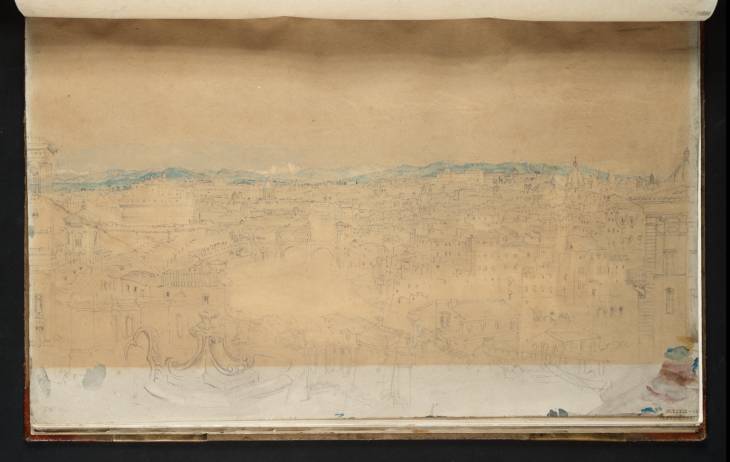Joseph Mallord William Turner View of Rome from the Gardens of the Villa Barberini 1819
Joseph Mallord William Turner,
View of Rome from the Gardens of the Villa Barberini
1819
Joseph Mallord William Turner 1775–1851
Folio 32 Recto:
View of Rome from the Gardens of the Villa Barberini 1819
D16358
Turner Bequest CLXXXIX 32
Turner Bequest CLXXXIX 32
Pencil, watercolour, white gouache and grey watercolour wash on white wove ‘Valleyfield’ paper, 229 x 368 mm
Stamped in black ‘CLXXXIX 32’ bottom right
Stamped in black ‘CLXXXIX 32’ bottom right
Accepted by the nation as part of the Turner Bequest 1856
Exhibition history
1904
National Gallery, London, various dates to at least 1904 (591).
1931
Display of Watercolours from the Turner Bequest, lent from the British Museum, National Gallery, Millbank, Tate Gallery, London 1931–March 1934 (no catalogue).
References
1904
E.T. Cook and Alexander Wedderburn (eds.), Library Edition: The Works of John Ruskin: Volume XIII: Turner: The Harbours of England; Catalogues and Notes, London 1904, no.591, pp.298, frame no.102, drawing no.222, 636, as ‘Rome. The Bridge and Castle of St. Angelo’.
1909
A.J. Finberg, A Complete Inventory of the Drawings of the Turner Bequest, London 1909, vol.I, p.563, as ‘The Bridge and Castle of St. Angelo. Pencil with part in water colour. Cf. p.34. 591, N.G.’.
1920
D[ugald] S[utherland] MacColl, National Gallery, Millbank: Catalogue: Turner Collection, London 1920, p.88.
1962
Martin Butlin, Turner: Watercolours, London 1962, p.38.
Turner’s location for this view of Rome was the Villa Barberini (also known as the Villa Barberini al Gianicolo), a small Baroque casino situated north of the Janiculum Hill, to the immediate south of St Peter’s and the Vatican. Originally owned by Taddeo Barberini, nephew of Pope Urban VIII, the building was largely destroyed during the siege of Rome in 1849,1 but its appearance is partially recorded in an eighteenth-century engraving by Giuseppe Vasi (1710–1782).2 Two small pavilions, the Casino della Palma, and the Palazetto Vercelli survived and are today part of a larger complex owned by the Jesuits and the Collegio di Propoganda Fide.
During the nineteenth century, the Villa Barberini was set within terraced gardens which offered spectacular views across the city. This sketch depicts the prospect looking east (upstream) towards the Ponte and Castel Sant’Angelo. Turner has carefully delineated the architecture of the topography laid out before him. On the far left-hand side can be seen the roof and tower of the Ospedale (Hospital) of Santo Spirito, whilst partially visible in the immediate foreground is the bell-tower of the Church of Santo Spirito in Sassia. On the far right-hand side is part of the façade of the Casino of the Villa Barberini with the dome of San Giovanni dei Fiorentini rising beyond. Related sketches from the same viewpoint can be found on folios 34 and 45 verso (D16361 and D16374) and on other loose sheets formerly bound within this sketchbook (D16327, D16329, D16333, D16347; CLXXXIX 1, 3, 7 and 21). There is also a single sketch within the Albano, Nemi, Rome sketchbook (see Tate D15368; Turner Bequest CLXXXII 39). This choice of view was unusual, but not without precedent.3
Like many drawings within the Rome C. Studies sketchbook, the composition has been executed in pencil over a washed grey background and Turner has added a small amount of watercolour and gouache to partially colour the line of the horizon. The use of blue for the distant line of the mountains beyond recalls the atmospheric effects of aerial perspective which characterise the paintings of the seventeenth-century master, Claude Lorrain (circa 1600–1682). John Ruskin described the work as ‘exquisite beyond description, in the loveliness of the colour on the distant hills’ and recommended it as ‘perhaps the most instructive piece of practice for the students of colour which can be found among the sketches’.4 Unfortunately, in common with many of the sketches and watercolours chosen for display during the late nineteenth and early twentieth centuries, the page has suffered from overexposure to light and the paper has become irreversibly faded and discoloured. Peter Bower has suggested that this is probably down to the high content of indigo in the grey watercolour wash, rather than properties within the paper.5
Nicola Moorby
July 2009
See for example Ferdinand Becker (died 1825), The Campanile of Santo Spirito in Sassia, reproduced in Raymond Keaveney, Views of Rome from the Thomas Ashby Collection in the Vatican Library, exhibition catalogue, Smithsonian Institution, Washington 1988, no.6, p.[71].
John Ruskin, ‘Catalogue of the Turner Sketches in the National Gallery’, London 1857, reproduced in Cook and Wedderburn (eds.), vol.XIII, p.298.
How to cite
Nicola Moorby, ‘View of Rome from the Gardens of the Villa Barberini 1819 by Joseph Mallord William Turner’, catalogue entry, July 2009, in David Blayney Brown (ed.), J.M.W. Turner: Sketchbooks, Drawings and Watercolours, Tate Research Publication, December 2012, https://www

